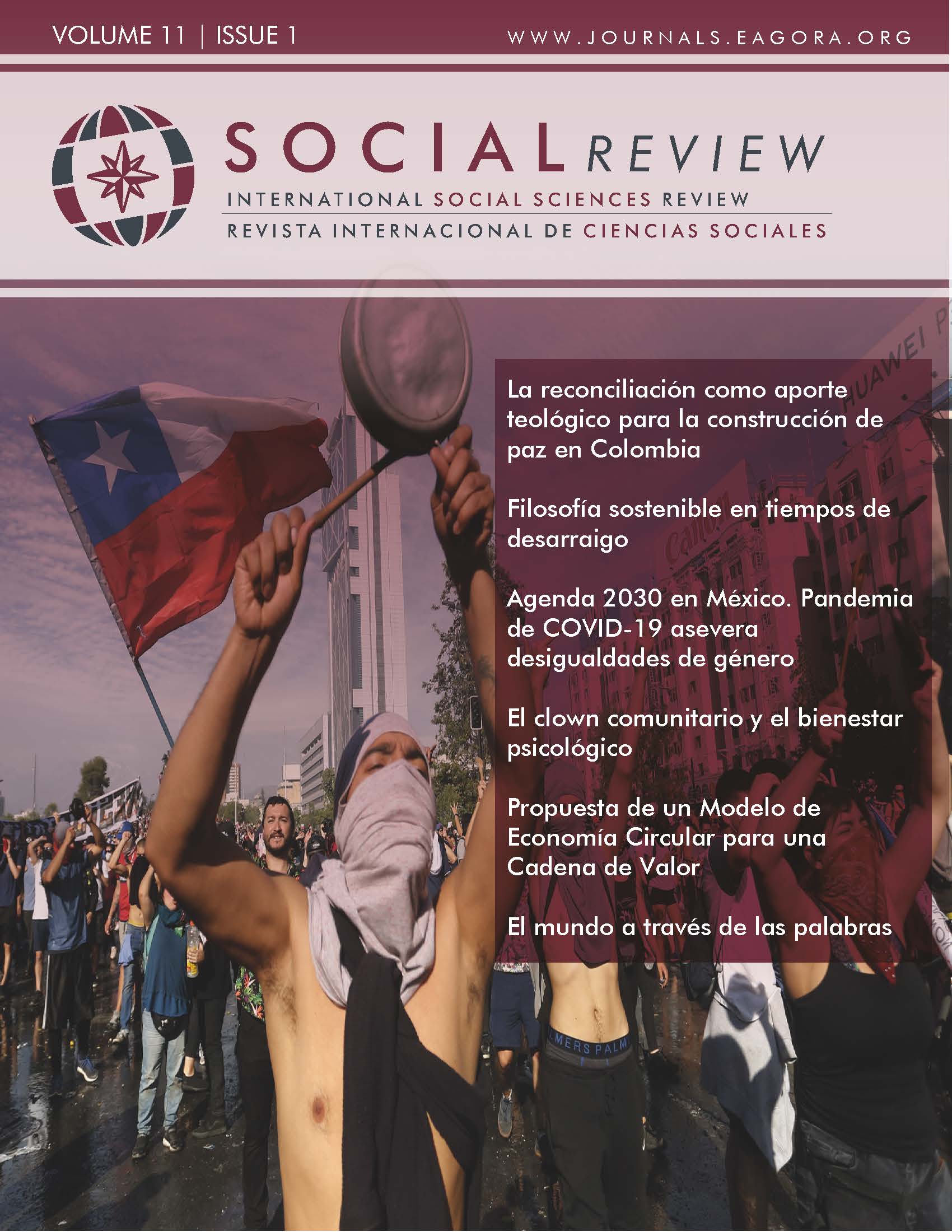Propuesta de un Modelo de Economía Circular para una Cadena de Valor
DOI:
https://doi.org/10.37467/gkarevsocial.v11.3421Palabras clave:
Economía circular, Modelo, Industria de alimentos, Sector lácteo, EstrategiasResumen
La industria de alimentos hoy responde a un sistema de producción lineal que utiliza porcentajes representativos de los recursos naturales y que genera grandes volúmenes de contaminación. Cartagena de Indias, es uno de los escenarios de esta problemática, por lo cual en la presente investigación se analiza el impacto que la empresa Coolechera causa en su medio, bajo la perspectiva de la economía circular. Se caracteriza la cadena de valor de la empresa, se diagnostica el estado actual de sus procesos misionales, y finalmente, se plantean estrategias que soporten la transición hacia un modelo circular.
Descargas
Estadísticas globales ℹ️
|
951
Visualizaciones
|
650
Descargas
|
|
1601
Total
|
|
Citas
Cartagena Cómo Vamos. (2017). Informe Calidad de Vida 2017- Ambiente. https://bit.ly/3B4aQhb
Castañeda Castro, L. H. (s. f.). Empaques y Medio Ambiente: Gestión de Residuos Sólidos. Catálogo del Empaque. https://bit.ly/3B8x8hS
Departamento Nacional de Planeación, Biointropic, & Universidad EAFIT. (2018). Estudio sobre Bioeconomía. Análisis del Sector de Alimentos y Bebidas. https://bit.ly/2KkPDFP
Do Rosario, F., Concepción Toledo, D. N., Barrios Castillo, G. y González Suárez, E. (2014). Gestion de los Residuos Sólidos y sus Impactos Económicos, Sociales y Medio Ambientales. Revista Centro Azúcar, 41(4), 9-20. https://bit.ly/3KEh0YE
Ellen MacArthur Foundation. (2017). The Concept of a Circular Economy [Institucional]. https://www.ellenmacarthurfoundation.org/circular-economy/concept
Ellen MacArthur Foundation. (2018). Cities and The Circular Economy for Food. Ellen MacArthur Foundation. https://ellenmacarthurfoundation.org/cities-and-circular-economy-for-food
Food Drink Europe. (2018). Ingredients for a Circular Economy. https://bit.ly/3eiK8Za
Gardiner, B. (2015). How Growth in Dairy Is Affecting the Environment. The International New York Times. https://nyti.ms/3q3fSEm
Gil, M. J., Soto, A. M., Usma, J. I. y Gutiérrez, O. D. (2012). Contaminantes emergentes en aguas, efectos y posibles tratamientos. Producción + Limpia, 7(2), 52-73. https://bit.ly/2MU2SyQ
Hernández-Berriel, M. del C., Aguilar-Virgen, Q., Taboada-González, P., Lima-Morra, R., Eljaiek-Urzola, M., Márquez-Benavides, L., & Buenrostro-Delgado, O. (2017). Generación y Composición de los Residuos Sólidos Urbanos en América Latina y el Caribe. Revista Internacional de Contaminación Ambiental, 32(1). https://bit.ly/3wQHz73 DOI: https://doi.org/10.20937/RICA.2016.32.05.02
Hurtado, J. (2000). Metodología de la Investigación Holística. Fundación Sypal.
Martínez Reyes, M. C. (2017). La Problemática de la Cultura del Empaque: Del Diseño Centrado en el Consumo, al Diseño Centrado en la Función Ambiental. [Trabajo de grado, Maestría, Universidad Nacional de Colombia]. https://repositorio.unal.edu.co/handle/unal/58688
Montero Castillo, P. M., Rodríguez Meza, J. E., & Martelo, R. J. (2018). Environmental Impacts of Agriculture, Livestock and Dairy Sector, 11(30), 1477-1489. https://bit.ly/3TCWBaA DOI: https://doi.org/10.12988/ces.2018.84140
Murillo Aguirre, J., & López Pedraza, D. (2016). Caracterización de la Cadena de Valor del Sector Lácteo Colombiano [Trabajo de grado, Universidad de la Salle]. https://bit.ly/3q6Y774
Osorio Gómez, J. C. (2017). Introducción al Pensamiento Sistémico. https://bit.ly/3KHHBUv
ProColombia. (s. f.). La Industria de los Lácteos en Colombia. ProColombia. https://bit.ly/3CSBcUW
Programa de las Naciones Unidas (PNUMA), Establecimiento Público Ambiental del Cartagena, & Observatorio del Caribe Colombiano. (2009). Perspectivas del Medio Ambiente Urbano: GEO Cartagena. http://www.pnuma.org/deat1/pdf/2009%20-%20GEO%20Cartagena.pdf
Puerta Valenzuela, D. C., Lambraño Escobar, L. L., & Cadrazco Florez, V. J. (2012). Estrategias Logísticas para un Desarrollo Sostenible [Proyecto de Investigación para optar al título de Ingeniería Industrial, Universidad de San Buenaventura]. https://bit.ly/3BaHrSJ
Restrepo Gallego, M. (2006). Producción Más Limpia en la Industria Alimentaria. Revista Producción + Limpia, 1(1). http://repository.lasallista.edu.co/dspace/handle/10567/217
World Wide Fund For Nature (WWF). (2018). Food for Thought: 91 PerCent of People Don’t Realize our Food System is The Greatest Threat to Nature, WWF survey. WWF. https://bit.ly/3q6wT0l
Descargas
Publicado
Cómo citar
Número
Sección
Licencia
Los autores/as que publiquen en esta revista aceptan las siguientes condiciones:
- Los autores/as conservan los derechos de autor.
- Los autores/as ceden a la revista el derecho de la primera publicación. La revista también posee los derechos de edición.
- Todos los contenidos publicados se regulan mediante una Licencia Atribución/Reconocimiento-SinDerivados 4.0 Internacional. Acceda a la versión informativa y texto legal de la licencia. En virtud de ello, se permite a terceros utilizar lo publicado siempre que mencionen la autoría del trabajo y a la primera publicación en esta revista. Si transforma el material, no podrá distribuir el trabajo modificado.
- Los autores/as pueden realizar otros acuerdos contractuales independientes y adicionales para la distribución no exclusiva de la versión del artículo publicado en esta revista (p. ej., incluirlo en un repositorio institucional o publicarlo en un libro) siempre que indiquen claramente que el trabajo se publicó por primera vez en esta revista.
- Se permite y recomienda a los autores/as a publicar su trabajo en Internet (por ejemplo en páginas institucionales o personales), una vez publicado en la revista y citando a la misma ya que puede conducir a intercambios productivos y a una mayor y más rápida difusión del trabajo publicado (vea The Effect of Open Access).













